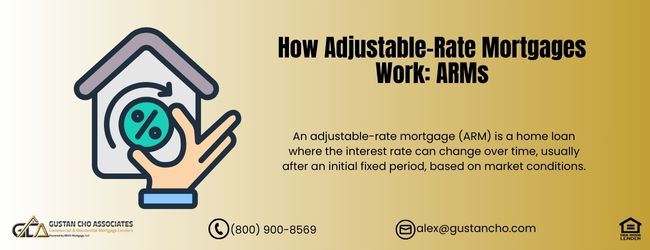How Adjustable-Rate Mortgages Work: ARMs

Adjustable-rate mortgages (ARMs) are becoming increasingly popular among borrowers due to their lower initial interest rates. They are a type of mortgage where the interest rate fluctuates periodically based on the market index or benchmark. In general, adjustable-rate mortgages offer a lower initial fixed-rate period than a 30-year fixed-rate mortgage loan. However, after the initial fixed-rate period, it adjusts every year for the mortgage loan term. The adjustment can be lower or higher than the initial fixed-rate period.
Borrowers also need to understand the complexity of ARMs to make informed decisions. Overall, ARMs can be suitable for some borrowers but require careful research.
ARMs are fixed for a certain period and adjusts year after year after the certain fixed rate period expires. The borrower’s monthly payments can rise or decrease depending on the changes in the market. While ARMs can offer potential savings in the short term, there are also risks involved that borrowers need to consider. This blog will discuss the good and the bad of adjustable-rate mortgages. In the following paragraphs, we will cover how adjustable-rate mortgages work.
Benefits of Adjustable-Rate Mortgages Versus Fixed-Rate
One of the most significant advantages of adjustable-rate mortgages is the lower initial interest rate than fixed-rate mortgages. ARM interest rates are often lower for the first few years, which can lead to lower monthly payments. This advantage can benefit borrowers who plan to sell or refinance their homes before the interest rate adjustments take effect.
ARMs can offer potential savings for borrowers who are willing to take risks. If the market interest rates decrease, the borrower’s monthly payments will also decrease, resulting in lower interest expenses.
If the market interest rates increase, the borrower’s monthly payments will also increase, resulting in higher interest expenses. ARMs have various terms and conditions tailored to the borrower’s financial situation. Borrowers can choose the length of the initial fixed-rate period, the margin, and the index. This flexibility allows borrowers to customize their loans to meet their financial goals. Click Here to Talk to our expert related to Adjustable-Rate Mortgages
What Are The Negatives of Adjustable-Rate Mortgages
One of the most significant disadvantages of ARMs is the unpredictability of monthly payments. Adjustable rate mortgages has an initial fixed-rate period for either a period of 3, 5, 7, or ten years. After the initial fixed-rate period passes, the interest rate adjusts every year based on the index and margin. Danny Vesokie, the President and CEO of Affiliated Affiliated Partners, Inc, a commercial loan officer training school based in Sacramento, California, explains the complexities of adjustable-rate mortgages:
ARMSs can offer potential savings for borrowers first-time homebuyers buying starter homes. The unpredictability of monthly payments and the risk of payment shock are disadvantages borrowers must consider choosing an ARM.
Adjustable-rate mortgages typically start with a lower interest rate than a fixed-rate mortgage. Since the interest rates can fluctuate based on the market index, the borrower’s monthly payments can increase or decrease, making it challenging to budget for monthly expenses. This unpredictability can lead to financial stress for some borrowers.
Payment Shock on Adjustable-Rate Mortgages
ARMs come with a risk of payment shock, which occurs when the interest rate adjusts significantly, resulting in a significant increase in monthly payments. This increase can be difficult for some borrowers to afford, leading to default or foreclosure. Borrowers need to understand the risks involved before choosing an ARM.
ARMs are more complex than fixed-rate mortgages, making them challenging for some borrowers to understand. Borrowers need to research and understand the terms and conditions of ARMs, including the margin and the index, to make informed decisions.
When purchasing a home, one of the biggest decisions you’ll have to make is what type of mortgage to choose. Two popular options are adjustable-rate mortgages (ARMs) and fixed-rate mortgages. In this blog post, we’ll also explore the pros and cons of adjustable-rate mortgages.
Fixed-Rate Versus Adjustable-Rate Mortgages
The primary difference between adjustable-rate mortgages and fixed-rate mortgages is the interest rate. A fixed-rate mortgage loan has a fixed interest rate for the entire loan duration, while an adjustable-rate mortgage loan has an interest rate that fluctuates based on market conditions. In other words, the interest rate on an ARM can go up or down over time.
One of the biggest advantages of an adjustable-rate mortgage is that the initial interest rate is usually lower than that of a fixed-rate mortgage loan.
This can make it easier to qualify for the loan and may result in lower monthly payments for the first few years. Another advantage of an ARM is that it can be a good choice for people who plan to sell their homes within a few years. Since the interest rate is typically lower for the first few years, you can save on interest payments before selling your home.
What Are The Benefits of Fixed-Rate Versus Adjustable-Rate Mortgages
One of the biggest downsides of an adjustable-rate mortgage is that the interest rate can increase over time, making it difficult to budget for your monthly mortgage payments. If the interest rate rises significantly, you may struggle to pay.
Another potential drawback of an ARM is that it can be more complicated than a fixed-rate mortgage. Since the interest rate can change, it’s important to understand how the loan works and be prepared for any changes.
Adjustable-Rate Mortgages (ARMs) are home loans with an interest rate that fluctuates over time. This means the monthly payments can go up or down, depending on the market conditions. ARMs are typically divided into the initial fixed-rate period and the adjustable period. The interest rate remains the same during the fixed-rate period, while it can change periodically during the adjustable period. This is finding the best lender for Adjustable-Rate Mortgages. Click Here to Apply For A Mortgage Loan Today
Finding the Best Lender for Adjustable-Rate Mortgages
If you’re considering an ARM, the first step is to find a lender that offers this type of loan. Not all lenders offer ARMs, so it’s essential to research and find one specializing in this area. Look for a lender with a good reputation, transparent communication, and competitive rates. It’s essential to understand the terms and conditions.
Adjustable-rate mortgages (ARMs) are mortgage loans with an intitial fixed-rate period. Ater the fixed-rate period passes, the interest rate fluctuates throughout the loan.
Adjustable-rate mortgages can increase or decrease over time, depending on market conditions. This type of mortgage is often a good option for buyers who plan to sell or refinance in a few years or expect their income to increase. Finding the best lender for an adjustable-rate mortgage can be a daunting task, especially for those who are first-time home buyers. It is essential to do your research and compare different lenders to find the one that best fits your needs. One way to find a suitable lender is by requesting referrals from family and friends who have recently purchased a home. They can provide valuable insight into their own experience and may be able to recommend a lender they had a positive experience with.
Shopping For The Best Adjustable-Rate Mortgages
You should shop for the best mortgage options when shopping for adjustable-rate mortgages. One option is to use online resources to compare different lenders. Websites allow you to input your information and receive quotes from multiple lenders. This can give you a better idea of the interest rates and fees associated with each lender, helping you make an informed decision.
It is also essential to consider the lender’s reputation and customer service. Look for reviews online and see if the lender has any complaints filed with the Better Business Bureau. A suitable lender should also be responsive and willing to answer any questions you may have throughout the process.
Lastly, remember to consider the terms of the loan itself. Look at the interest rate, any fees associated with the loan, and the loan length. Ensure you understand all the terms and ask questions if anything is unclear. This type of mortgage can be an excellent option for some home buyers. Still, it’s essential to understand the pros and cons before deciding.
What Type of Mortgage Loan Is Best For You
If you should decide to buy, before you begin looking for a home and during the process, we have vast experience working with buyers to get them ready to purchase their dream home. We can take you through the entire financing process for your home loan and show you both options, an ARM or a fixed-rate loan.
Adjustable-rate mortgages can be a good choice for some home buyers, especially those who plan to sell their homes within a few years. However, they come with some risks and disadvantages, so it’s essential to carefully consider your options before deciding. Ultimately, your best choice will depend on your financial situation and long-term goals.
We also can connect you to title companies/attorneys and real estate agents in your area that can help as needed. Call or text Gustan Cho at GCA FORMS Mortgage Group at 262-627-1965. Text us for a faster response. Or email us at gcho@gustancho.com for more information and further assistance. The team at GCA FORUMS Mortgage Group is an experienced in all types of loan options, from government, and conforming loans to alternative financing loan options. The team at GCA FORUMS Mortgage Group has successfully guided many homeowners through obtaining a home on both the lending and real estate side. The team at GCA FORUMS Mortgage Group does not represent buyers or sellers but offers free consultation in 48 states at GCA FORUMS Mortgage Group by connecting homeowners, buyers, and sellers to the needed sources. Click Here to Contact Our Expert About Your Mortgage Enquiry
In this Last Section, We Will Cover FAQs on Adjustable-Rate Mortgages
Below is a series of questions and answers (Q&As), which is a structure of disclosure concerning the rates on adjustable-rate mortgages (ARM) in home loans:
What does an adjustable-rate mortgage mean?
An adjustable-rate mortgage (ARM) is a home loan granted at an initial fixed interest rate at the start of issuance. Only to allow the interest rate structure to change at a specified period. The period when the adjustable-rate mortgages change is referred to as reset. Adjusting the interest rate for the period relates to market conditions. When the adjustable-rate mortgages reset, it may increase or decrease the monthly mortgage payments.
How do ARMs work?
As an option, please consider this: a typical ARM plan may feature accords where the first installment has a fixed interest period of either five years, seven years, or ten years as per period. The interest switches periodically after the fixed period in a manner defined, e.g., every other two years. The fixed rate for the next period ends with the said change, and the amount of the tenant based on this new rate has now been calculated.
Types of ARMs Chart: How many ARMs are in the USA?
3/1 ARM: Fixed-rate mortgage for the first three years, which then rate is adjusted for everyone in 12 months.
5/1 ARM: The mortgage rate is fixed for the first five years after the closing, after which it changes at one year.
7/1 ARM: It applies a constant interest rate for the first seven years and then changes it at least once a year.
10/1 ARM: It has a rate locked for the first ten years, after which the rate changes once every year.
The fixed number refers to the period with a stable rate, and the number following the slash refers to the period after the stable period in how often new rates may be introduced.
What Are the Advantages of Adjustable-Rate Mortgages
Lower Initial Interest Rate: During the initial fixed-rate period, ARMs typically offer a lower interest rate than fixed-rate mortgages during the same period interest.
Lower Initial Monthly Payments: This initial lower rate helps the borrowers have low monthly payments for the fixed period. They will only be in a customary position briefly before making changes.
Flexibility: ARMs could also be useful when planning to increase income or sell a house before the fixed-rate period ends.
What Are the Risks of an ARM?
Payment Shock. There are periods when interest is offered at a fixed rate. But after that period, the interest and the monthly payment can rise to such proportions that it can be said the borrower suffers what can be termed as “payment shock”
Rate Uncertainty: With most adjustable-rate mortgages, only the payment can change. However, where the rate is linked to some index, it is possible that the rate can go up or down, although the borrowers are not privy to the time or extent to which the changes can occur.
Complexity of Adjustable-Rate Mortgages
An arm is generally unruly. They are relative to borrowers which makes their average to be simple cognitively because relative simple interest was the main means of keeping repayment.
What are the indices in an ARM?
When market expectations estimate the index interest rate, it is called an index rate. Some sophisticated indices employed include LIBOR, the London Interbank Offered Lending Rate. This index is mostly active for ARMS but is impending usefulness.
SOFR: A very specific category of index swaddle that has replaced the LIBOR
CMT: It is market-based on the yield of the U.S. treasury security.
COFI: Cofi is the average interest most financial institutions pay on their deposit liabilities, which are of different weights.
What is the Margin in ARM?
Thus, the margin is the percentage added to the index figure when determining a new rate at the end of the initial adjustment period. For instance, if the index I is 2% and the margin M is 2.5%. It means the new interest rate will be I+M. In this case, it will be 4.5%
What Are Rate Caps in an ARM?
These notions, called rate caps, define what, in percentage, is the highest fluctuation of interest rates at the prescribed intervals of the loan or even throughout the entire tenure. There are following factors which include, though not limited to:
Initial Adjustment Cap: This is not for type mortgages with more than 0% since this applies to the high-interest-only method, for which some cap will apply after some time.
Subsequent Adjustment Cap: This is also placed on every subsequent post-first adjustment of the changing rate.
Lifetime Cap: This puts an overall ceiling on how much over long periods of time and mortgage installments the borrower can expect to pay.
What is a Payment Cap?
A cap limits the maximum monthly payment increase during a single adjustment period. This is regardless of how much the interest rate rises. However, if your payment cap is reasonably lower than the payment that has to be made, that excess may be added to the loan, resulting in negative amortization.
What is Negative Amortization?
Negative amortization occurs when you do not make the amount expected to be paid monthly to reduce the loan. You can also pay the interest and hope that the interest remaining unpaid will be added to the principal balance. Hence, even though you are in the process of making payments, your obligation can increase over time.
What Happens When the Initial Fixed Period Ends?
When the first fixed rate, the interest rate applicable to the borrower, is reset concerning an index and a margin, any rate specified as applicable to any loans outstanding following an adjustment will apply. It will apply only for a defined period (generally up to one year). This is followed by the loan and its straightforward monthly repayments.
Can I refinance my ARM before the scheduled rate adjustment?
Yes, you can close on a rate refinance on an ARM before the market evolves into a different rate. This is especially useful when you head for fixed-rate mortgages or when lower rates are possible. However, given the circumstances, one has to consider the rates and determine how feasible.
What Important Factors Must I Keep in Mind While Selecting an ARM?
Future Rate Adjustments: Rates and payments could go up or down in the future.
Financial Stability: Keen understanding of and being prepared to be flexible to increase or move downward towards a more expensive payment level should there be increased interest rates in the future.
Length of Stay: Try also to check how long you expect to live in the home. If short, then the great initial rate, lower, may be very useful.
Market Conditions: Consider current interest rates, the economic space where you are, and the forecasted one.
Are ARMs available on all kinds of mortgages?
ARMS are also available for various mortgages, such as conventional V.A., FHA, Jumbo, and non-QM loans. If such provisions exist on ARMs with these loan types, they must also be understood.
Is Extra Payment Towards the ARM Principal Allowed?
You can pay a certain amount of the principal on an ARM as an extra payment, just like on fixed-rate mortgages. In my case, this feature is available on fixed-rate mortgages. This may enable you to reduce the amount of mortgage owed more quickly so that the downside after the subsequent adjustments is minimized.
What is the main difference between ARM and fixed-rate loans? ARM:
It has a lower promotional rate than the index. It can only be adjusted after several years. On the other hand, amortization takes place at specific timelines through an adjustment index.
Fixed-Rate Mortgage: The set interest known to the borrower remains constant throughout the loan period. Hence, the borrower pays the same amount every month.
Am I a good candidate for an ARM? An ARM could be useful for you for the following reasons
You think that interest rates will not go up anymore or will fall. You plan to relocate or refinance within a period shorter than the fixed period. You would like to keep lower payments during the first few months. But you are okay with the idea of having them increase later.
However, if the goal is not to keep changing the dollar amounts of the payments, rather than caring about the changes, then a fixed-rate mortgage would be preferable.
Adjustable rate mortgages (ARMs) have advantages, such as lowering payments or introducing aggressive initial rates. Still, there is that chance at some time in the future, you might have to increase your payments as the rates are dynamic due to the risks associated with ARMs. They enable you to get the best mortgage when appropriate, considering all the necessary ARM terms and their caps and changes. They usually go beyond value retirement tools and seek to serve within the property and real estate market to guide you on which mortgage would best suit your condition.
FAQs About How Adjustable-Rate Mortgages Work: ARMs
1. What is an adjustable-rate mortgage (ARM)? An adjustable-rate mortgage (ARM) is a home loan where the interest rate can change over time, usually after an initial fixed period, based on market conditions.
2. How does the interest rate on an ARM change? The rate on an adjustable-rate mortgage fluctuates according to a market index. Following the initial fixed-rate period, the rate may increase or decrease, impacting your monthly payments.
3. What are the benefits of adjustable-rate mortgages? One advantage of ARMs is the lower starting interest rate, potentially leading to reduced monthly payments in the initial years of the loan.
4. What are the risks of adjustable-rate mortgages? The main concern is that it may become more challenging to budget if the interest rate rises after the initial fixed period, causing potential increases in your monthly payments.
5. How long does the initial fixed-rate period last in an ARM? Typically, the initial fixed-rate period for an ARM lasts for 3, 5, 7, or 10 years, depending on the loan terms.
6. Can my monthly payment go down with an adjustable-rate mortgage? Yes, if market interest rates decrease, your monthly payment could go down after the fixed-rate period.
7. Who might benefit from an ARM? If you plan to sell or refinance your home before the interest rate changes or expect your income to increase, you might benefit from lower initial payments with an ARM.
8. What is payment shock in adjustable-rate mortgages? Payment shock happens when the interest rate adjusts after the fixed period, and the new monthly payment is much higher than before.
9. Can I refinance out of an ARM? Yes, if market conditions are favorable, you can refinance an ARM into a fixed-rate mortgage before the interest rate adjusts.
10. What should I consider before choosing an adjustable-rate mortgage? It would help if you considered your financial stability, how long you plan to stay in the home, and whether you are comfortable with the risk of increasing payments.







Responses